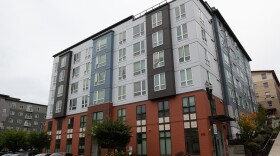A Tacoma nonprofit that supports the Asian and Pacific Islander population in Washington state has a new building.
When Asia Pacific Cultural Center began providing services nearly 30 years ago, it worked out of a room that was about 150 square feet. Its new building in South Tacoma is 18,500 square feet and cost $19 million to construct.
The nonprofit, which represents the 47 countries and cultures in the Asia and Pacific Islands region, puts on arts and culture, business and mental health programming. Faaluaina Pritchard, the executive director, said prior to this new space the cultural center's programming was scattered.
"We were renting, spending money renting outside, and traveling, too," she said. "We used to travel everywhere to do our services. Now, a lot of them will be here."
Pritchard said the second floor of the new building includes an Asia Pacific library and cubicles for staff. The main floor of the building includes a commercial kitchen, which will open the door for a new program.
"We're going to do Asia Pacific culinary with an entrepreneurship program along with it, so that we could help those people become restaurant owners," she said. The nonprofit is still developing that program, which she said will likely be ready next year.
The building also features a tea room, a performing arts center, and an art gallery, which Pritchard said is a big upgrade from previous spaces.
"We now have our own gallery space — we have a gallery room," she said. "Before we used to display our visual arts in the hallway."
Pritchard said the cultural center will solicit Asia Pacific artists to show their work at the gallery, rotating every two months.
While the nonprofit owns the building, Parks Tacoma owns the land it sits on. In 2020, the independent park district entered a 20-year lease with the cultural center to operate the building at South Park.
Pritchard said the City of Tacoma, Pierce County and Washington state helped fund it.
She estimated the new space will allow Asia Pacific Cultural Center to serve roughly 400,000 people a year — about 100,000 more than before. And because there's a lot more to see in the building, Pritchard hopes visitors stick around to participate in the programming.






